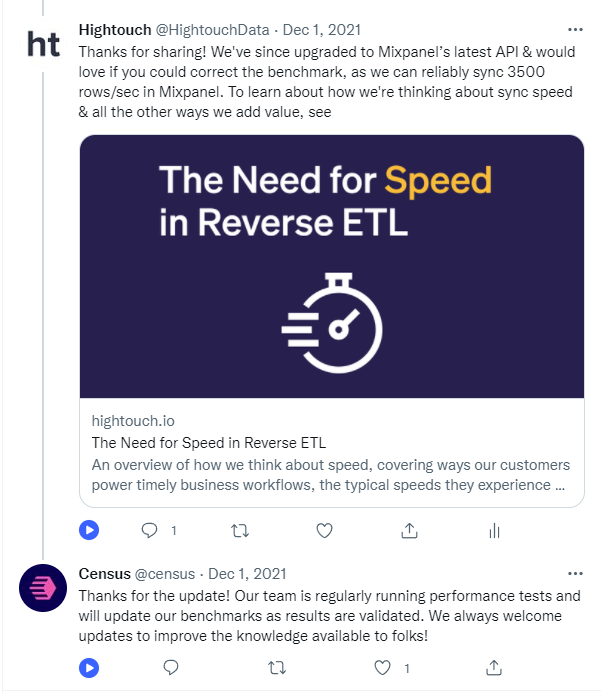Competitive Benchmarks & Our Focus on Customer Value
An update on speed in the RETL competitive landscape

Tejas Manohar
February 1, 2022
7 minutes
Case #2: Misleading Benchmarks - Hightouch vs. Census on Mixpanel
In Census’s following blog post titled “Census 44x faster than Hightouch for event syncs,” the company portrays Hightouch to be much slower at “large-scale event syncs.” We found that the root cause for this example of a slow sync time came from a very (and I mean, very) specific feature of one of our 100+ destinations that simply needed an API update.
A fix was shipped within 2 hours of a customer reporting the issue. The issue we corrected was that Hightouch’s Mixpanel integration was released before Mixpanel’s new bulk import API, and we had not updated our integration to use the latest API, which was ~50x faster. After releasing the change, the speed of our Mixpanel syncs are now at par with Census’s.
The customer ultimately chose Hightouch for data activation, emphasizing that the speed at which we resolved their report only solidified Hightouch as their vendor of choice.
Census’s benchmarks are for competitors, not customers
While this series of competitive benchmarks are advertised as a commitment to transparency to customers, we feel the way they’re presented indicates the opposite.
We’re starting with large-scale event sync workflows, arguably where speed and scale matter the most.
Their blog post implies that Hightouch is slower for “large-scale event syncing” use cases. That’s pretty misleading, as the discrepancy in speed is just one use case of one of our 100+ destinations that was resolved within 2 hours of a customer report.
We invite Hightouch and any other reverse ETL providers to share updated benchmarks so we can collectively push this category of data tooling to new heights.
On top of that, Census’s blog states that they welcome vendors to share updated benchmarks, but despite reaching out multiple times, Census still hasn’t updated their public benchmarks and continues to share these outdated materials in head-to-head sales.

Educating the Buyer: What Should You Make Of Reverse Etl Vendor Benchmarks?
There is no magic. It’s all in the details — Walt Disney
As a technologist, when I see benchmarks as extreme as 44x or 87x faster, the sirens in my head go off. Either the technologies are fundamentally different or the benchmarks are misleading. It’s as simple as that.
Reverse ETL isn’t rocket science. The use cases in these competitive benchmarks are quite straightforward. There’s nothing novel in either Hightouch or Census’s underlying architecture to drastically speed up a simple batch sync of data from your warehouse to SaaS tools, and it’s only disingenuous to imply so in either direction.
Fundamentally, Reverse ETL syncs are bottlenecked by the speed at which the destination APIs can accept data. Hence, max speeds between the tools are comparable.
Closing Thoughts
Misleading benchmarks are nothing new. There are similar debates between Snowflake and Databricks and outside of the data space, Intel and Apple regarding M1 chips.
We understand the need for speed in Reverse ETL and are committed to serving the most real-time use cases. If there’s any case that we’re not up to the performance requirements of our customers’ use cases, just reach out– we’re all ears and would jump on it.
For more direction on how to compare Reverse ETL tools, check out our Hightouch vs. Census page or ask our sales team for customer references.

While there’s not much room to differentiate in speed for the most basic Reverse ETL use cases, the market is always forcing us to push forward the boundaries of technology in the space.
We like to be uber-transparent about our roadmap. This is what helps top companies like Warner Music Group, Auto Trader, and Flickr take a bet on Hightouch as the industry leader in such an early space. Most of the work our team is doing isn’t related to sync speed, but there are some really interesting initiatives we’re working on that push what’s possible here.
Here’s a few examples -
- Real-time event forwarding: We have a private beta for syncing data from streaming sources like Kafka, Kinesis, Materialize, Segment, and webhooks.
- Optimized delta calculations: Hightouch automatically only syncs changed data to destinations. This process can be sped up for event syncs.
- Multi-region: Today, Hightouch can store data in your own cloud (AWS, GCP, Azure) and region of choice, but all data is transiently processed in the US. We’re deploying our Reverse ETL pipelines across the globe so if your warehouse or destination (e.g. email server) is in a non-US region, your data doesn’t have to go around the world and back. This has both speed and compliance benefits.
We founded Hightouch with a mission to help our customers activate their data to drive business outcomes. Regardless of the competitive environment, our commitment to our customers is to stay laser-focused on exactly this.



